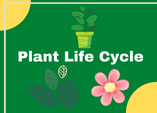The Life Cycle of a Plant Diagram
Game
The life cycle game on the life cycle of a plant online. Drag and drop the different stages from seeds, seedlings to mature plant.
 A plant's life cycle is made up of various phases. In the vegetative stage, a seedling grows upwards. During its growth, it needs various things to survive. At maturity, a plant has a strong root system, many branches, and leaves. Once it has finished its growth, it will produce flowers and seeds. Then, it will die and go through the process of germination and dispersal.
A plant's life cycle is made up of various phases. In the vegetative stage, a seedling grows upwards. During its growth, it needs various things to survive. At maturity, a plant has a strong root system, many branches, and leaves. Once it has finished its growth, it will produce flowers and seeds. Then, it will die and go through the process of germination and dispersal.
The life cycle of a plant is a complex process. A plant will begin its life as a seed, then grow until it reaches maturity. After that, it will produce flowers. When these flowers bloom, it will reproduce itself and continue its life cycle. The next stage in the life cycle is called reproduction. The plants in the garden and on your porch are mature plants, which will produce seeds and produce fruit. During their reproductive stage, they will die.
The life cycle of a plant is complicated, with alternating generations of the same type of plant. A plant will have both haploid and diploid reproductive structures, and it will alternate between sexual and asexual reproduction. This complexity allows for great variation in a single species. The general life cycle of a plant is represented by the interactive diagram above. Pollen from the spores moves to the pistil and produces seeds.
A plant's life cycle begins with the seed. It grows upwards towards the sun and above ground, getting nutrients from the soil through its roots and the sunlight captured through its leaves. A seedling's leaves contain chlorophyll, which uses light, water, and carbon dioxide to produce energy. This process is called photosynthesis, and it is what helps the seedling grow into a mature plant with flowers. Eventually, the seedling will be able to reproduce and produce flowers.
A flower has two parts, a male part called a stamen, and a female part called a pistil. Both parts are important for seed formation, as pollen must reach the pistil in order for a seed to form. A flower consists of several stages, starting from the spores to the seeds. Its life cycle varies according to the stage of a flower.
In the vegetative stage, the plant continues to grow until it matures. This is the time for a plant to produce its first flowers. Once they are mature, the plant reproduces by producing new plants. Then, the cycle continues. During the vegetative stage, seeds are protected by a hard outer coat. After the seed has reached maturity, the embryo has a root, a shoot, and the first true leaves.
A plant's main reproductive parts are its flowers. It produces pollen and fruits. Some plants have both male and female parts. The pollen fertilizes the female parts, while the female produces seeds. These seeds are the embryonic stage of the plant. These are the reproductive parts of a plant. They produce new leaves and buds to reproduce. If the female flower is fertile, it will produce seeds. In turn, pollen will fertilize the female part of the flower and make the flowers that grow into a seed.
I hope you now understand the important part flowers play in our lives. They are beautiful and can be found being sold at a slower shop. However, without flowers we shall not have most of the sweet fruits we all love today. Without these fruits as well, we would not be able to have the seeds of these plants which we end up planting in our gardens. If you want to have an idea of plant life cycles, do not hesitate to play the interactive online game above.
In the UK system of education, this is equivalent to science for year 2, year 3, year 4, year 5, year 6, year 7 and year 8.
